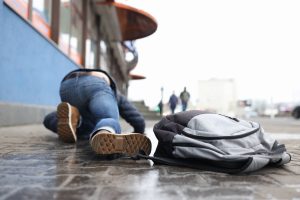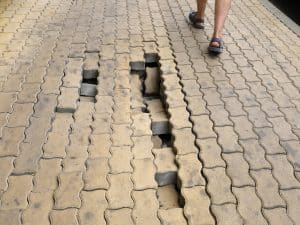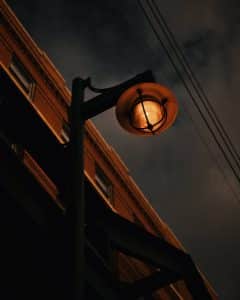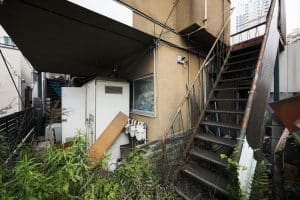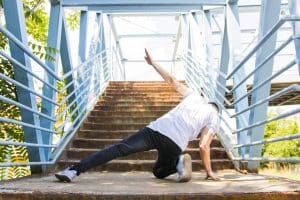The exterior of a residential home is often considered a sanctuary, a place where we can relax, socialize, and enjoy the outdoors. However, it’s important to be aware of potential dangers that can lead to injuries. From slippery surfaces to overgrown foliage, there are several hazards that homeowners should be mindful of to ensure the safety of friends, family and guests.
Following these simple and easy recommendations will not only ensure safety but reduce the exposure to liability claims:
1)Slippery Surfaces: One of the most prevalent dangers around the exterior of a residential home is slippery surfaces. Wet or icy pathways, decks, and driveways can lead to painful slips and falls. To prevent such accidents, homeowners can:
-
- Regularly clean and maintain pathways and driveways.
- Install non-slip surfaces or mats in areas prone to moisture.
- Clear snow and ice promptly during the winter months.
- Ensure proper drainage to prevent water accumulation.
2) Uneven Walkways: Uneven or cracked walkways and driveways can be hazardous, especially for elderly family members or children. To address this issue:
-
- Regularly inspect concrete or stone surfaces for cracks and damage.
- Repair or replace damaged sections.
- Use textured materials for a better grip.
3) Poor Lighting: Inadequate exterior lighting can create a breeding ground for accidents during the night. To enhance safety, homeowners can:
-
- Install motion-activated lighting around pathways, entrances, and key areas.
- Regularly check and replace bulbs to maintain proper illumination.
- Consider solar-powered lights for energy efficiency.
4) Overgrown Foliage: Overgrown bushes, trees, and shrubs can obstruct walkways and create hiding spots for pests. To mitigate this danger:
-
- Prune and trim foliage regularly to maintain clear pathways.
- Keep a safe distance between plants and the home to prevent damage.
- Remove dead branches to prevent falling debris.
5) Faulty Railings and Balusters: Porches, balconies, and staircases are often equipped with railings and balusters. When these safety features become loose or damaged, they can pose significant risks. To address this issue:
-
- Regularly inspect railings and balusters for stability.
- Tighten screws and replace damaged parts promptly.
- Consider replacing older railings with more durable materials.
6) Tripping Hazards: Various small objects, like toys, garden tools, or hoses, can create tripping hazards. To maintain a clutter-free exterior:
-
- Store garden tools and equipment in designated areas.
- Teach children to put away their toys after playing.
- Coil and store hoses properly to prevent tangling.
7) Pools and Water Features: Pools, ponds, and other water features can be delightful but also risky. Homeowners with such amenities should:
-
- Install and maintain secure safety barriers and fencing around pools to prevent accidental falls.
- Keep pools covered and secure when not in use.
- Maintain proper water quality to prevent slipperiness and bacterial growth.
None of this is rocket science. It’s obvious that attention to property maintenance can significantly reduce the risk of accidents.
Let’s look at the hazards and line them up with potential adverse outcomes.
Slippery surfaces. The most common consequence of failure to clear snow and ice is a fall. Wet leaves on a cedar deck can be as hazardous as ice. Injuries associated with falls range from fractures (hip, femur, wrist, shoulder) to joint injury (tendon and meniscus tears) to brain injury. When an individual falls on her bottom, her upper torso is often whipped back resulting in contact of the occiput (back of the head) with an unyielding surface.
Uneven surfaces and tripping hazards (toys etc). These hazards lead to falls forward. Shoulder, wrist and facial injuries are most common.
Poor lighting. Falls resulting from hazards hidden in the dark are unpredictable but often lead to facial trauma as the victim cannot see objects in the path of her descent.
Faulty railings etc. These hazards are particularly onerous as they can cause a fall from an elevated height. These falls often result in life-altering spinal cord or brain injury.
Pools and water features. These hazards care the most insidious, the most dangerous and the most unforgiving. Unprotected or poorly protected pools or water features can lead to death of young children or brain damage through near-drowning incidents (anoxia). Fractures heal. There is no remedy, no fix for the loss of a child. There is no rest, no reprieve from a lifetime of caring for a child suffering from profound brain injury due to anoxia.
The law requires that a home owner take ‘reasonable steps’ to ensure a property is ‘reasonably safe’. This is the legal test for liability. Reasonable steps to ensure the property is reasonably safe. The law does not require perfection but the definition of the word reasonable changes when we measure the possible dangers against the effort that a homeowner must take to make a property safe. It is not enough to make a pool mostly safe against accidental entry by toddlers. It is not enough to make a walkway leading into a home safe only on occasions when the homeowner is expecting guests. It is not enough to salt and sand the steps but not the walkway because that’s what all the neighbours do.
In the end, the greatest service a homeowner can do for guests, delivery drivers, or anyone entering the property is to ensure that homeowner’s insurance is in place. It is the great safety net that ensures our mistakes are not visited upon innocent victims of negligence.
The lawyers at Bergeron Clifford do not defend homeowners who are subject to injury claims on the basis of failure to follow these simple safety rules. We represent plaintiffs only – those who have fallen victim to unsafe practices and sustained injury. If you are a homeowner who is the subject of such a claim, we won’t be asking questions that only a rocket scientist can answer. We’ll be asking about whether you followed the simple steps set out in this article but more importantly, whether you were wise and kind enough to ensure your property was covered by liability insurance.
You don’t have to be perfect as a homeowner but mistakes happen. Be sure you protect us all with liability insurance.
Edward Bergeron
Ted Bergeron is a Queen’s University graduate with degrees in Physical Education, Arts, Education and Law.
Ted’s legal career started in insurance defence litigation. He worked at a boutique law firm in Toronto, servicing only insurance companies. He switched to representing only injured clients and their families in 1995. He knows both sides of the system inside and out.
He has lectured extensively in the School of Rehabilitation Therapy, the School of Physical and Health Education and the Faculty of Law at Queen’s University. He has worked in a volunteer capacity with the Law Society of Upper Canada as an instructor in the Bar Admission Course teaching Civil Litigation.

